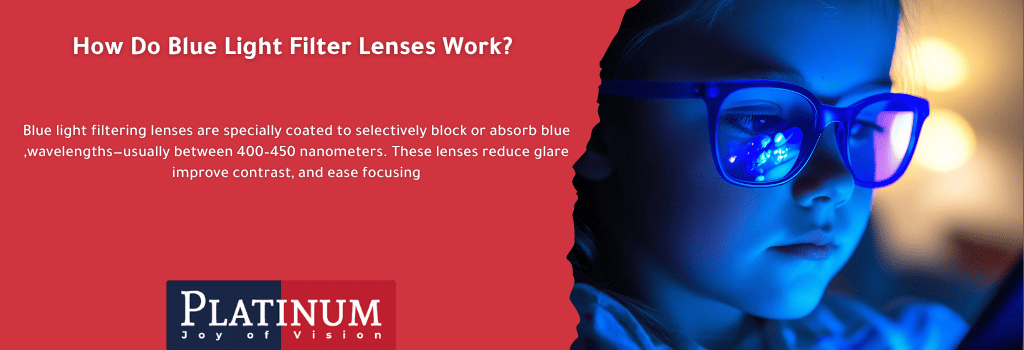In today’s screen-driven world, many customers visit optical shops and clinics complaining of eye fatigue, dryness, or headaches—yet few understand the root cause. Digital Eye Strain (DES) is increasingly common, and blue light filtering lenses are becoming one of the most effective tools for managing it. As an optical professional, your role isn’t just to provide vision correction, but also to educate your customers on why they’re feeling discomfort—and how the right lenses can help.
Here’s how to educate your customers clearly, confidently, and effectively.

What Is Digital Eye Strain?
Start with a simple, relatable explanation. Digital Eye Strain—also known as Computer Vision Syndrome—is a group of symptoms caused by prolonged exposure to screens. It affects people of all ages, especially those who spend more than 2 hours a day on devices like:
- Computers and laptops
- Tablets and smartphones
- TVs and gaming consoles
Typical Symptoms to Explain:
- Tired, burning, or itchy eyes
- Blurry vision or difficulty refocusing
- Headaches or neck/shoulder tension
- Sensitivity to light
- Trouble sleeping (due to screen use at night)
Use real-life scenarios to connect:
“Do you find yourself rubbing your eyes by midday at work?”
“Do your kids complain of tired eyes after long tablet use?”
What Is Blue Light and Why Is It a Problem?
Blue light is a high-energy visible (HEV) light emitted by digital screens and LED lighting. While blue light occurs naturally in sunlight (and helps regulate our circadian rhythm), artificial blue light is overabundant and disruptive—especially at night.
What You Should Highlight:
- Blue light scatters more in the eye, reducing contrast and causing strain.
- Excess exposure at night suppresses melatonin, the hormone that regulates sleep.
- Over time, cumulative exposure may contribute to retinal stress and macular changes.
Explain it simply:
“Blue light keeps your brain awake. That’s good in the morning, but a problem at 10 PM when you’re trying to fall asleep.”

How Do Blue Light Filter Lenses Work?
Blue light filtering lenses are specially coated to selectively block or absorb blue wavelengths—usually between 400–450 nanometers. These lenses reduce glare, improve contrast, and ease focusing.
Clarify the Types of Filters:
- Mild filters (clear lenses): Ideal for office use and general wear—block around 20-30% of blue light.
- Stronger filters (yellow/amber lenses): Used for gamers, night shift workers, or those with severe sensitivity—can block up to 90% of blue light.
Mention advanced coatings like MIRA Blu from Platinum, which combine blue light protection with anti-reflective and anti-smudge layers for full comfort.
How to Guide the Customer in Choosing the Right Lens
Ask questions to personalize the advice:
- “How many hours a day do you spend on screens?”
- “Do you feel more tired after working on your computer?”
- “Do you get dry eyes or headaches by the end of the day?”
Match Their Lifestyle to a Solution:
| Customer Profile | Recommendation |
| Office worker | Blue filter with anti-glare coating |
| Gamer/graphic designer | High-contrast blue cut lens |
| Student | Basic blue filter lens |
| Night shift worker | Amber-tinted strong filter |
Show sample lenses or let them try on demo frames—experience makes the difference.
Debunk Common Myths
Customers may ask:
- “Isn’t blue light natural?”
Yes, but screens expose us to concentrated levels for long hours. - “Can I just lower my brightness?”
That helps, but doesn’t filter the blue spectrum itself. - “Do these lenses darken my screen?”
Not if you’re using clear blue-filter lenses—they’re nearly invisible and won’t alter colors.
In-Store Educational Tips
- Use signage that explains blue light effects in simple terms.
- Place digital eye strain brochures at checkout or waiting areas.
- Offer free mini-assessments for screen usage and strain.
- Train your team to recognize digital strain symptoms during consultations.
- Suggest screen-free tips like the 20-20-20 rule:
Every 20 minutes, look 20 feet away for 20 seconds.
Final Tip: Connect the Lens to Their Wellbeing
End every consultation with a benefit-driven message:
“These lenses won’t just help you see better—they’ll help your eyes feel better by the end of your day.”
FAQs:
Q1: What exactly is digital eye strain?
A: Digital eye strain, also called computer vision syndrome, is a group of eye and vision problems that result from prolonged screen use. It can cause symptoms like tired eyes, headaches, blurred vision, and neck pain because screens make us blink less and force our eyes to constantly refocus.
Q2: How does blue light from devices affect my eyes?
A: The blue light emitted by screens and LED lights is high-energy visible light. While some blue light during the day is normal, too much artificial blue light – especially at night – can lead to eye strain, disrupt your sleep cycle, and may potentially contribute to long-term eye health issues.
Q3: Do blue light glasses actually help?
A: Yes, quality blue light glasses are effective. They work by filtering out the most harmful blue-violet light (between 400-450 nm) while allowing beneficial blue-turquoise light to pass through. This reduces glare, improves visual contrast, and helps minimize eye fatigue. Higher-end options like MIRA Blu coatings also include anti-reflective and smudge-resistant properties.
Q4: Who would benefit most from wearing blue light glasses?
A: Blue light glasses are particularly helpful for people who spend more than 2 hours daily on screens, experience eye discomfort after device use, frequently use screens at night, or have sensitive eyes. They’re especially valuable for office workers, students, gamers, and anyone with a family history of eye health concerns.
Q5: Can I get blue light protection with my prescription glasses?
A: Absolutely. Blue light filtering can be added to virtually any prescription lenses, including single-vision, progressive, and reading glasses. You can choose from clear lenses that block about 20-30% of blue light for everyday use, or more specialized amber-tinted lenses that filter up to 90% of blue light for nighttime use or gaming. Many premium options combine blue light protection with other beneficial features.
Conclusion
Digital eye strain is no longer a rare condition—it’s the new normal. As more people rely on screens to work, study, and socialize, blue light filters are not a luxury—they’re a necessity. Educating customers not only builds trust but helps them make informed choices that improve both vision and comfort.
By recommending the right lens—like those from Platinum’s MIRA Blu range—you’re not just selling eyewear. You’re offering protection, performance, and peace of mind in a digital world.

